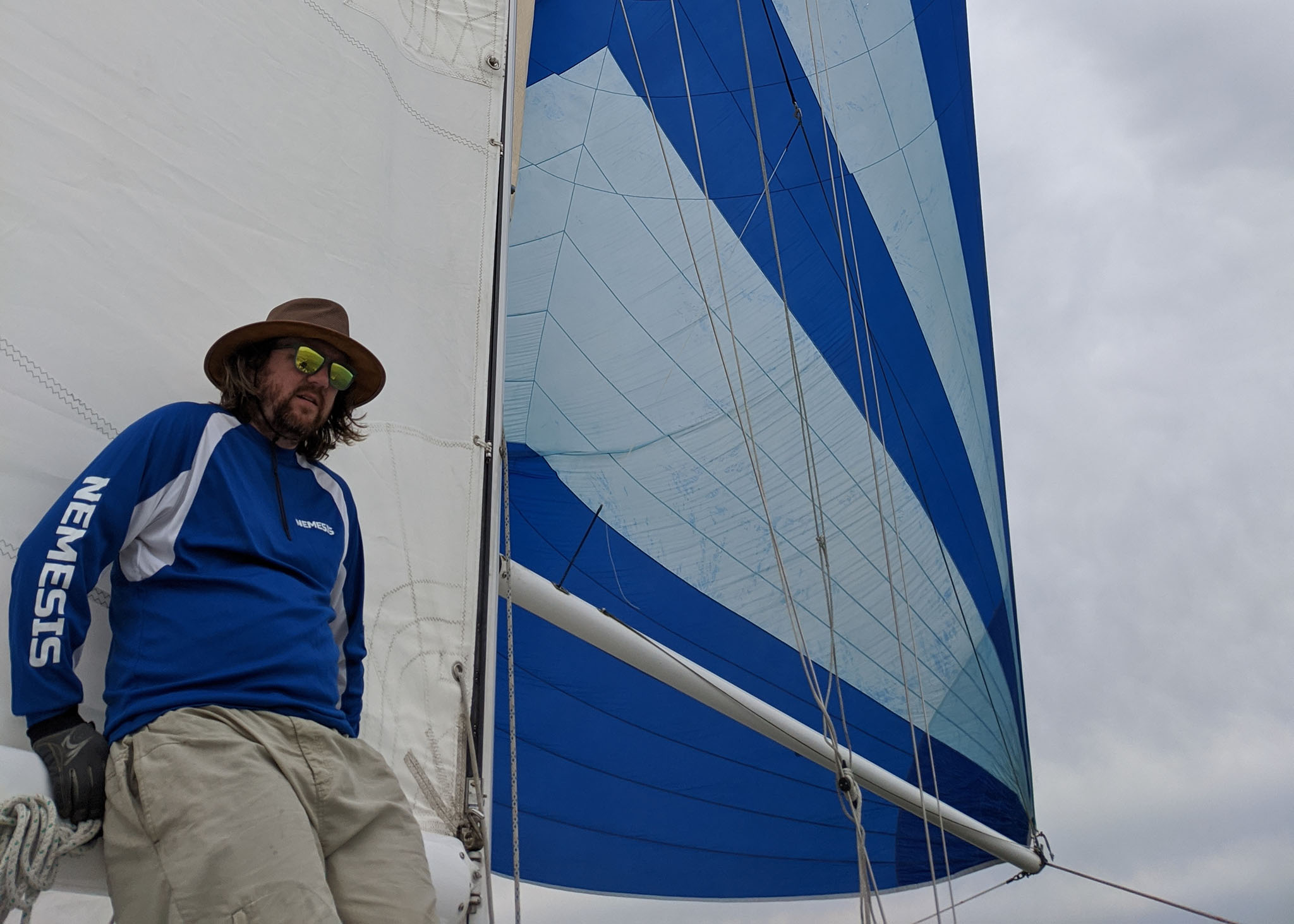Sailboat racing is an interesting sport. Things move really slowly, until they don’t. A few weeks ago, Shannon and I went out on Nemesis, a race boat that we often race on, for some spinnaker practice. This was in preparation for the Bay Cup I race, an annual two part race out in Galveston bay. We’ve done this race on Nemesis a few times now, with varying degrees of success, but this time we were going to fly the spinnaker. That’s when things can get crazy, and it did.
The pre-start was fairly uneventful. 20-30 boats all checking in with race committee, and then jockeying for start position while testing the wind to see how best to race the course. We had about 8 minutes to start, when we started to consider that we had the wrong sail up for the wind conditions. We had expected a bit more wind so we had the small headsail up. If we had hurried, we probably could have done a quick sail swap in time, but we would have lost a lot of positioning time, and been very tired even before the race started. Its a lot of work to do a swap, especially in a hurry. We decided to go with what we had.
Once the race started and we are heading upwind on the first tack it became fairly apparent that we were slow. many of the boats we usually handily beat, especially on the upwind legs were staying right with us. Enough so that our planned early tack could not occur because we were too close to other racers. The boat was trimmed nicely, and sailing nicely, but we seemed to have been missing that half a knot and 2-3 degrees that we usually have on these legs. It could be the sail, it could be the bottom is dirty, it could be a lot of things, but we just were not making the progress we wanted.

About 3/4 into the leg, we finally have our opportunity to tack and execute it smoothly. things are clear and were starting to make progress as we actually got a bit of a wind shift timed with the tack. Taking a sweep of the nearby boats, I notice many boats are still on the opposite tack, but behind us, just not too far. One boat in particular, Bad Girl, a boat we are regular faster than, was quite a bit higher than us, on the opposite tack, and holder her course.
We continue on this tack, but I’m watching Bad Girl continue to get closer, but her bearing to is isn’t changing. Closing distance, constant bearing. That’s sailor speak, and a good way to tell if you are on a collision course. This is not an uncommon occurrence, sailboat racing is a slow game that is won and lost by 1-2 degrees of course changes, 1-2mm of trim changes, a few pounds of weight here or there. All to make .2 knots of speed. Another few minutes pass, she is still right there, just closer still. I notify Tim on the helm, and suggest we either need to tack now, or fall off a bit and go behind them. Racing and sailing rules are pretty clear about this. The boat on the starboard tack (Bad Girl) is the “stand on” boat, and the boat on port tack (us) is the “give way” boat.
Tim is now aware of the situation, but we are usually so much faster then her, he is convinced we will pass in front, but it will still be close. We are now about 200 yards away, and I again make note that we are still closing distance, but constant bearing. We have to do something now, or we risk collision. Tim holds the course.
50 yards. This is happening. I call out to Tim we HAVE to tack, and I tell the crew to move and prepare for a tack. This is where things get dicey. Things are pretty slow on a boat, and you usually have lots of time to move and prepare. In cased like this you need to move NOW. Tacking, especially a quick emergency tack can be fairly violent. Lines flying everywhere, the boom swinging across the cockpit, the boat heeling over from one side to the other. There are plenty of ways to her hurt in that situation so we hold course trying to prepare.
5 yards. Oh shit, its too late. Even if we make the turn now, they will still hit us. Two 10k+ lb boats moving at 7 knots is a ton of energy to change direction. Lots of call-outs between the boats. “STARBOARD!!!” from them announcing they have the rights, “HOLD YOUR COURSE!” from Tim as he still thinks we will pass them. He is wrong.
At the very last second, both boats react. Hard emergency tacks on both sides. Lots of yelling commands, lots of flapping sails and grunting trimmers, everyone is doing exactly what is needed to avoid a collision. I was releasing the main, releasing the jib sheets and watching the collision all at the same time. Everything was in slow motion, yet moving quickly.
Millimeters, I swear, only millimeters between the two boats. That’s how close it was. I cannot believe we did not hit.

The situation could have been better, but given what happened both boats handled it perfectly. If either boat had reacted in instant slower, or either crew didn’t do their jobs, there would have been a massive collision and someone would have gotten hurt. As we recover from the mess, we have to do our penalty turns, a full 360 loop. This is not an easy task for a sailboat, that as tack and a jibe in quick succession, and we are all still processing what just happened.
The rest of the race was comparatively uneventful. We did get to fly the spinnaker, which in itself is worthy of a story, but we really just were in a daze. We finish the race, not last, but close. Bad Girl is there right in front of us celebrating their class win, and we apologize about the incident and any remaining hard feelings are dropped.
Sailing is a slow sport, until it is not. a 1-2 degree course shift when I first noticed the collision course could have avoided the situation. That’s how easily things can go wrong. Well, its a lesson learned, and experience gained, and nobody got hurt. Lets not do that again.






Good idea not to repeat that. On the bright side, you are on the water, catching ocean breezes, while we are practicing social distancing and wondering how long before we run out of toilet paper.
More worried about champagne than toilet paper at the moment 🙂